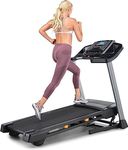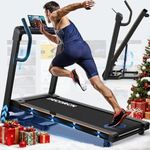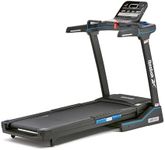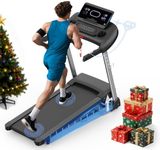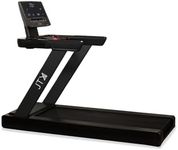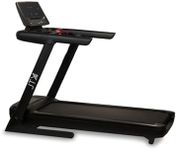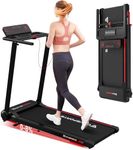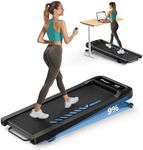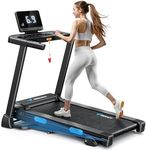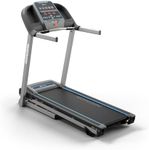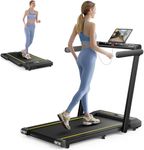Buying Guide for the Best Buy Treadmills
Buying a treadmill can be a great investment in your health and fitness. To ensure you choose the right treadmill for your needs, it's important to understand the key specifications and how they align with your fitness goals and usage patterns. Here are some important factors to consider when selecting a treadmill.Motor PowerThe motor power of a treadmill is measured in horsepower (HP) and determines how smoothly and efficiently the treadmill operates. A higher HP is important for more intense workouts and for users who plan to run frequently. For walking or light jogging, a motor with 2.0 to 2.5 HP is usually sufficient. For regular running, look for a motor with at least 3.0 HP. If you are a heavier user or plan to do high-intensity training, consider a motor with 3.5 HP or more.
Running SurfaceThe running surface, or belt size, is the area on which you run or walk. A larger running surface provides more comfort and safety, especially for taller users or those with a longer stride. For walking, a belt size of 16-18 inches wide and 45-50 inches long is generally adequate. For running, look for a belt that is at least 20 inches wide and 55-60 inches long. If you have a particularly long stride, you may need an even longer belt.
CushioningCushioning refers to the shock absorption system of the treadmill, which reduces the impact on your joints while running or walking. Good cushioning is important for preventing injuries and providing a more comfortable workout. Treadmills with adjustable cushioning allow you to customize the level of shock absorption. If you have joint issues or plan to use the treadmill frequently, look for models with superior cushioning systems.
Incline and Decline SettingsIncline and decline settings allow you to simulate uphill and downhill running, adding variety and intensity to your workouts. Incline settings can help you burn more calories and target different muscle groups. Most treadmills offer an incline range of 0-10%, but some go up to 15% or more. Decline settings are less common but can provide additional workout options. If you want to challenge yourself and add variety to your workouts, look for a treadmill with a wide range of incline and decline settings.
Speed RangeThe speed range of a treadmill indicates how fast the belt can move. For walking, a maximum speed of 6-8 mph is usually sufficient. For jogging, look for a treadmill with a top speed of 8-10 mph. For serious runners or those who want to do sprint training, a treadmill with a top speed of 12 mph or higher is recommended. Consider your fitness goals and current fitness level when choosing the appropriate speed range.
Weight CapacityThe weight capacity of a treadmill indicates the maximum user weight it can safely support. It's important to choose a treadmill with a weight capacity that exceeds your body weight to ensure durability and safety. Most treadmills have a weight capacity of 250-300 pounds, but some heavy-duty models can support up to 400 pounds or more. If you are a heavier user, make sure to select a treadmill with a higher weight capacity.
FoldabilityFoldability refers to the ability to fold the treadmill for easy storage. This is an important feature if you have limited space in your home. Foldable treadmills can be easily stored in a closet or against a wall when not in use. If space is a concern, look for a treadmill with a reliable and easy-to-use folding mechanism.
Console FeaturesThe console features of a treadmill include the display and controls for tracking your workout metrics, such as speed, distance, time, and calories burned. Some treadmills also offer advanced features like heart rate monitoring, built-in workout programs, and connectivity options for apps and entertainment. Consider what features are important to you and how they can enhance your workout experience. If you enjoy tracking your progress and staying entertained while exercising, look for a treadmill with a feature-rich console.
